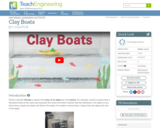
Students design, build and test model clay boats that can hold weight.
- Subject:
- Science
- Material Type:
- Lesson
- Provider:
- TeachEngineering
- Provider Set:
- TeachEngineering
- Date Added:
- 10/14/2015

Students design, build and test model clay boats that can hold weight.

Students observe and discuss a simple balloon model of an electrostatic precipitator to better understand how this pollutant recovery method functions in cleaning industrial air pollution.

Engineers design methods of removing particulate matter from industrial sources to minimize negative effects of air pollution. In this activity, students will undertake a similar engineering challenge as they design and build a filter to remove pepper from an air stream without blocking more than 50% of the air.

Posed with a paradigmatic engineering problem, students consider and explore mathematical algorithms and/or geometric concepts to devise possible solutions. The problem: How should a robotic vacuum move in order to best clean a floor of unknown shape and dimensions? They grapple with what could be a complex problem by brainstorming ideas, presenting the best idea for a solution and analyzing all presented solutions, and then are introduced to an elegant solution. Rather than elaborately calculating the most efficient route and keeping track of which tiles the robot has visited, a random number generator determines which direction the robot will take when it hits a barrier. Students are able to visually confirm how an unfamiliar programming concept (a random number generator) can make for a simple and efficient program that causes an NXT robot (that is suitably equipped) to clean a bare floor. Then students think of other uses for random numbers.

Following the steps of the engineering design process and acting as biomedical engineers, student teams use everyday materials to design and develop devices and approaches to unclog blood vessels. Through this open-ended design project, they learn about the circulatory system, biomedical engineering, and conditions that lead to heart attacks and strokes.

In this self-paced tutorial, educators learn about the kinds of educational experiences that prove effective in exciting students about STEM careers and identify resources that can be used to introduce students to STEM careers, especially those related to climate change science. Profiles of scientists and engineers representing diverse populations are included for use in the classroom. Multimedia educational resources including video clips and vocabulary words linked to a glossary are included. This is the eighth of ten self-paced professional development modules providing opportunities for teachers to learn about climate change through first-hand data exploration.

In this career-oriented interview, readers are introduced to the manager of several farmer's markets in Portland, Oregon. Following a brief description of his job and the general operations of a farmer‰Ûªs market, he explains why these venues are beneficial to the vendors, the customers and the environment. The Climate Kids website is a NASA education resource featuring articles, videos, images and games focused on the science of climate change.

An interview conducted with a building contractor provides insights into what it means to build an environmentally "green" house. This lesson is part of the Climate Kids website, a NASA education resource featuring articles, videos, images and games focused on the science of climate change.

This career-oriented interview features a home energy auditor. He describes his job responsibilities and offers tips for improving home energy efficiency. The Climate Kids website is a NASA education resource featuring articles, videos, images and games focused on the science of climate change.

Using her countywide program as an example, a recycling educator offers incentives for recycling by providing data on energy savings and explaining how her county in Michigan supports the program. The Climate Kids website is a NASA education resource featuring articles, videos, images and games focused on the science of climate change.

In this career-oriented interview, readers are introduced to a scientist who works primarily on wind energy. He explains the importance of wind farm placement planning. Images of architectural wind and a wind farm are included, along with a link to the Power Up game. The Climate Kids website is a NASA education resource featuring articles, videos, images and games focused on the science of climate change.

A landscaper explains, through an interview format, how it is possible to design and maintain yards and gardens that require very little water. The Climate Kids website is a NASA education resource featuring articles, videos, images and games focused on the science of climate change.

The article addresses this question by suggesting environmentally friendly actions to help reduce carbon footprints, trash production, and water usage. ‰ÛÏGreen‰Û� careers are also discussed. The Climate Kids website is a NASA education resource featuring articles, videos, images and games focused on the science of climate change.
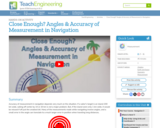
Accuracy of measurement in navigation depends very much on the situation. If a sailor's target is an island 200 km wide, sailing off center by 10 or 20 km is not a major problem. But, if the island were only 1 km wide, it would be missed if off just the smallest bit. Many of the measurements made while navigating involve angles, and a small error in the angle can translate to a much larger error in position when traveling long distances.

Students analyze international oil consumption and production data. They make several graphs to organize the data and draw conclusions about the overall use of oil in the world.

In this task using a number line, students must partition the interval between 0 and 1 into eighths.
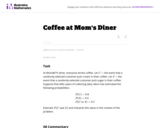
This task assesses a student's ability to use the addition rule to compute a probability and to interpret a probability in context.

Students are exptected to identify the slope of the line with the unit rate in this real world problem.
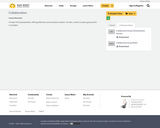
A Power Point presentation offering effective communication starters. As well, a rubric to assess group work is included.
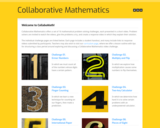
This website has various video challenges with accompanying PDF's for student use . Students are able to post their own videos of how they solved the challenge, and take a look at how others solved it as well.